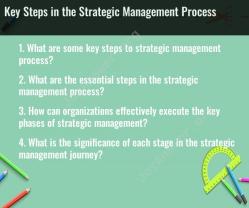What are some key steps to strategic management process?
Strategic management is a systematic approach to setting an organization's long-term goals and objectives and determining the best ways to achieve them. The strategic management process typically involves the following key steps:
Establishing a Mission and Vision:
- Define the organization's mission, which outlines its core purpose and reason for existence.
- Create a vision statement that describes the desired future state or long-term goals for the organization.
Conducting a Situation Analysis:
- Analyze the internal environment, including strengths and weaknesses within the organization.
- Analyze the external environment, including opportunities and threats in the industry and market.
Setting Objectives and Goals:
- Define specific, measurable, achievable, relevant, and time-bound (SMART) objectives and goals that align with the organization's mission and vision.
Developing a Strategy:
- Formulate a strategy that outlines the approach and actions the organization will take to achieve its objectives and respond to its internal and external factors.
- This often involves selecting a competitive strategy (e.g., cost leadership, differentiation, focus) and making strategic choices.
Implementing the Strategy:
- Put the formulated strategy into action by allocating resources, setting priorities, and making decisions that align with the chosen strategy.
Monitoring and Evaluating Progress:
- Continuously monitor the execution of the strategy to ensure it's on track.
- Collect and analyze relevant data to measure progress and make adjustments as needed.
Taking Corrective Actions:
- If the organization encounters challenges or deviations from the planned strategy, take corrective actions to get back on course.
Communicating and Engaging:
- Communicate the strategy and progress to employees, stakeholders, and other relevant parties to ensure alignment and support.
- Engage employees and stakeholders in the strategic process, encouraging their involvement and buy-in.
Reviewing and Updating:
- Periodically review and update the strategic plan to adapt to changing internal and external conditions.
- Ensure that the strategy remains relevant and effective in achieving the organization's goals.
Strategic Control and Feedback:
- Establish control mechanisms and feedback loops to ensure that the strategy is being followed and is effective.
- Use feedback to make informed decisions and adjustments as needed.
These steps in the strategic management process are typically iterative and require ongoing attention and adaptation as the business environment evolves. Effective strategic management helps organizations navigate challenges, make informed decisions, and work toward their long-term success.
What are the essential steps in the strategic management process?
The essential steps in the strategic management process are:
- Set goals and objectives. What does the organization want to achieve? What are its long-term and short-term goals?
- Analyze the environment. What are the organization's strengths, weaknesses, opportunities, and threats?
- Formulate a strategy. How will the organization achieve its goals and objectives? What are its competitive advantages?
- Implement the strategy. How will the organization put its strategy into action?
- Evaluate and control. How well is the strategy working? Are the organization's goals and objectives being achieved?
How can organizations effectively execute the key phases of strategic management?
Organizations can effectively execute the key phases of strategic management by:
- Involving stakeholders at all levels. Strategic management is not just a top-down process. All stakeholders, including employees, customers, and suppliers, should have a voice in the process.
- Communicating the strategy clearly. Once the strategy is formulated, it needs to be communicated clearly to all stakeholders. Everyone needs to understand the strategy and how it will be implemented.
- Providing resources and support. The organization needs to provide the resources and support necessary to implement the strategy. This includes financial resources, human resources, and technological resources.
- Monitoring and evaluating progress. The organization needs to monitor and evaluate the implementation of the strategy to ensure that it is on track and that the desired results are being achieved.
What is the significance of each stage in the strategic management journey?
Each stage of the strategic management journey is significant because it contributes to the overall success of the organization.
- Setting goals and objectives provides a clear direction for the organization and helps to align everyone's efforts.
- Analyzing the environment helps the organization to identify its strengths, weaknesses, opportunities, and threats, and to develop a strategy that capitalizes on its strengths and minimizes its weaknesses.
- Formulating a strategy provides a roadmap for how the organization will achieve its goals and objectives.
- Implementing the strategy is where the rubber meets the road. This is where the organization puts its plan into action and makes things happen.
- Evaluating and controlling is essential to ensure that the organization is on track and that its goals and objectives are being achieved.
By effectively executing each stage of the strategic management process, organizations can increase their chances of success in the long term.


